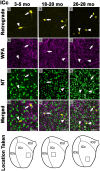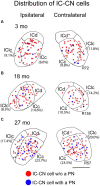Age-related upregulation of perineuronal nets on inferior collicular cells that project to the cochlear nucleus
- PMID: 38053844
- PMCID: PMC10694216
- DOI: 10.3389/fnagi.2023.1271008
Age-related upregulation of perineuronal nets on inferior collicular cells that project to the cochlear nucleus
Abstract
Introduction: Disruptions to the balance of excitation and inhibition in the inferior colliculus (IC) occur during aging and underlie various aspects of hearing loss. Specifically, the age-related alteration to GABAergic neurotransmission in the IC likely contributes to the poorer temporal precision characteristic of presbycusis. Perineuronal nets (PNs), a specialized form of the extracellular matrix, maintain excitatory/inhibitory synaptic environments and reduce structural plasticity. We sought to determine whether PNs increasingly surround cell populations in the aged IC that comprise excitatory descending projections to the cochlear nucleus.
Method: We combined Wisteria floribunda agglutinin (WFA) staining for PNs with retrograde tract-tracing in three age groups of Fischer Brown Norway (FBN) rats.
Results: The data demonstrate that the percentage of IC-CN cells with a PN doubles from ~10% at young age to ~20% at old age. This was true in both lemniscal and non-lemniscal IC.
Discussion: Furthermore, the increase of PNs occurred on IC cells that make both ipsilateral and contralateral descending projections to the CN. These results indicate that reduced structural plasticity in the elderly IC-CN pathway, affecting excitatory/inhibitory balance and, potentially, may lead to reduced temporal precision associated with presbycusis.
Keywords: Wisteria floribunda agglutinin; aging; cochlear nucleus (CN); inferior colliculus; perineuronal nets.
Copyright © 2023 Almassri, Ohl, Iafrate, Wade, Tokar, Mafi, Beebe, Young and Mellott.
Conflict of interest statement
The authors declare that the research was conducted in the absence of any commercial or financial relationships that could be construed as a potential conflict of interest.
Figures






Similar articles
-
The Density of Perineuronal Nets Increases With Age in the Inferior Colliculus in the Fischer Brown Norway Rat.Front Aging Neurosci. 2020 Feb 11;12:27. doi: 10.3389/fnagi.2020.00027. eCollection 2020. Front Aging Neurosci. 2020. PMID: 32116654 Free PMC article.
-
Inferior collicular cells that project to the auditory thalamus are increasingly surrounded by perineuronal nets with age.Neurobiol Aging. 2021 Sep;105:1-15. doi: 10.1016/j.neurobiolaging.2021.04.001. Epub 2021 Apr 21. Neurobiol Aging. 2021. PMID: 34004491 Free PMC article.
-
Perineuronal nets and GABAergic cells in the inferior colliculus of guinea pigs.Front Neuroanat. 2014 Jan 8;7:53. doi: 10.3389/fnana.2013.00053. eCollection 2014. Front Neuroanat. 2014. PMID: 24409124 Free PMC article.
-
Wisteria Floribunda Agglutinin-Labeled Perineuronal Nets in the Mouse Inferior Colliculus, Thalamic Reticular Nucleus and Auditory Cortex.Brain Sci. 2016 Apr 13;6(2):13. doi: 10.3390/brainsci6020013. Brain Sci. 2016. PMID: 27089371 Free PMC article.
-
Topographical and cellular distribution of perineuronal nets in the human cochlear nucleus.Hear Res. 2009 Aug;254(1-2):42-53. doi: 10.1016/j.heares.2009.04.008. Epub 2009 Apr 19. Hear Res. 2009. PMID: 19383535
Cited by
-
Age-related upregulation of dense core vesicles in the central inferior colliculus.Front Cell Neurosci. 2024 May 1;18:1396387. doi: 10.3389/fncel.2024.1396387. eCollection 2024. Front Cell Neurosci. 2024. PMID: 38774486 Free PMC article.
References
-
- Alibardi L. (2002). Putative inhibitory collicular boutons contact large neurons and their dendrites in the dorsal cochlear nucleus of the rat. J. Submicrosc. Cytol. Pathol. 34, 433–446. PMID: - PubMed
Grants and funding
LinkOut - more resources
Full Text Sources

